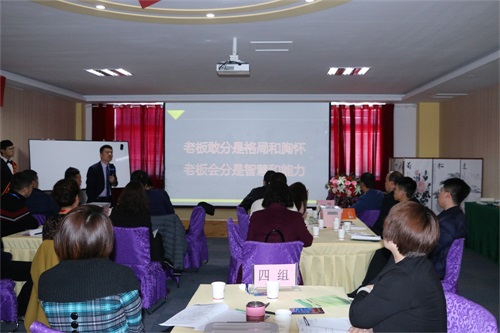如果
山东股权激励缺乏条件和限制,无法发挥其可持续价值,则很可能失去“长期激励”的特征。为了防止激励被视为奖励,一些激励对象在获得公司股权后失去了继续奋斗的动力,选择睡在现有权益上。我们强调,在实施股权激励时,可以设置一定的激励条件,鼓励员工努力工作以此获得股权和后续收益,创造可持续价值。
If Shandong equity incentive lacks conditions and restrictions and cannot exert its sustainable value, it is likely to lose the characteristics of "long-term incentive". In order to prevent incentives from being seen as rewards, some incentive objects lose the motivation to continue to struggle after acquiring equity in the company and choose to sleep on their existing interests. We emphasize that when implementing equity incentives, certain incentive conditions can be set to encourage employees to work hard to obtain equity and subsequent benefits, and create sustainable value.
如何定“条件”?定条件,即在股权激励方案设计中确定激励对象的考核条件。
How to set "conditions"? Setting conditions, that is, determining the evaluation conditions of incentive objects in the design of equity incentive schemes.
1、从企业层面考虑,如果企业整体业绩条件未达标时,则所有激励对象不得行权或解锁获益;如果公司业绩达标时,则所有激励对象满足了行权或解锁的条件之一者,再具体根据个人业绩条件确定是否满足考核要求。
1. From the perspective of the enterprise, if the overall performance conditions of the enterprise do not meet the standards, all incentive objects shall not exercise their rights or unlock benefits; If the company's performance meets the standards, all incentive objects who meet one of the conditions for exercising or unlocking the rights will be determined based on their individual performance conditions to determine whether they meet the assessment requirements.
2、于激励对象个人而言,具体授予比例与个人业绩考核结果挂钩。方案设计阶段确切的标明条件,将会避免很多在方案执行过程中可能遇到的阻力与困惑。
2. For the individual incentive target, the specific award ratio is linked to the individual performance evaluation results. The precise marking of conditions during the scheme design phase will avoid many obstacles and confusion that may be encountered during the implementation of the scheme.
在具体定条件操作中,根据企业具体现状制定针对性的考核标准,例如,以考核结果记录得分,由100分—60分划分为5个标准,分别标记为ABCDE五档,对应的每档设定不同的授予比例,比如1.2、1、0.8、0.6、0,以此为依据确定对股权激励对象的考核条件及标准。
In the specific condition setting operation, specific evaluation criteria are formulated based on the specific situation of the enterprise. For example, the scores recorded based on the evaluation results are divided into five criteria, from 100 to 60 points, and are marked as five levels of ABCDE. The corresponding levels are set with different grant ratios, such as 1.2, 1, 0.8, 0.6, and 0, to determine the evaluation conditions and standards for equity incentive objects.
3、设定阶梯式条件
3. Set stepped conditions
阶梯式条件,指的是公司在实施股权激励时,并不是只设定一个目标条件,而是在个目标条件的基础上再设定一个或多个目标条件,并且这种分段式的目标条件呈逐级向上攀升的状态。
Stepwise conditions refer to the fact that when a company implements equity incentives, it does not set only one target condition, but instead sets one or more target conditions based on the first target condition, and this segmented target condition is in a state of gradual upward climb.

阶梯式条件往往是公司制定的一种持续小目标下的中期目标条件,因为如果直接设定一个中期目标,一来目标过远,实现需要的时间较长;二来会影响到员工对激励的无望情绪,造成激励计划逐渐流产,不利于形成激励。因此,才将中期目标条件分割成若干个小目标条件来逐步实现。
Ladder conditions are often medium term target conditions set by a company under a continuous small goal, because if a medium term goal is directly set, the goal is too far away and it takes a long time to achieve; Secondly, it can affect employees' hopelessness towards motivation, resulting in the gradual abortion of incentive plans, which is not conducive to the formation of incentives. Therefore, the medium-term target conditions are divided into several small target conditions to gradually achieve them.
设定阶梯式激励条件的注意事项如下:
Precautions for setting stepped excitation conditions are as follows:
(1)在设定阶梯式激励条件时,应把握好额度。不是激励的额度高,就一定能达到激励的目的,一定不要因额度的不断加大而干扰到正常的价格利润空间。
(1) When setting stepped incentive conditions, it is necessary to grasp the quota. "If the amount of incentive is not high, it is certain that the purpose of incentive can be achieved. It is important not to disturb the normal price profit space due to the continuous increase of the amount.".
(2)阶梯式条件一经设定,即会成为激励的考核标准,所以在设定阶梯式激励条件时,企业一定要考虑到逐级兑现的问题。
(2) Once set, the ladder type conditions will become the evaluation criteria for incentives. Therefore, when setting the ladder type incentive conditions, enterprises must consider the issue of gradual fulfillment.
(3)在设定阶梯式激励条件时,应明确规定以正当手段来提升业绩。比如区域代理,应严格规定不许跨区域销售或私自降价销售,因为这样虽然可以增加这一区域的业绩,但势必会影响到其他区域的业绩,同时公司的整体业绩并未提升,还助长了恶意竞争,影响到长远发展。
(3) When setting stepped incentive conditions, it should be clearly stipulated that legitimate means should be used to improve performance. For example, regional agents should strictly prohibit cross regional sales or private price reduction sales, because although this can increase the performance of this region, it is bound to affect the performance of other regions. At the same time, the overall performance of the company has not improved, which also encourages malicious competition and affects long-term development.
(4) When setting stepped incentive conditions, companies should consider from a longer-term perspective to avoid short-term incentive behavior. This requires that incentive conditions should not be set solely for the purpose of improving the company's short-term performance, but rather from a medium to long-term perspective. For more relevant content, please visit our website http://www.lushangyun.com consulting service


 13698613138
13698613138


